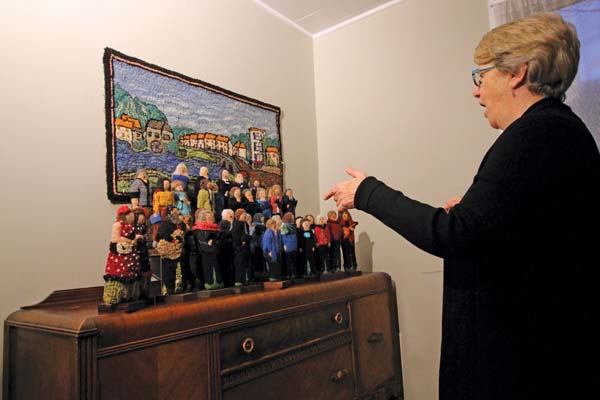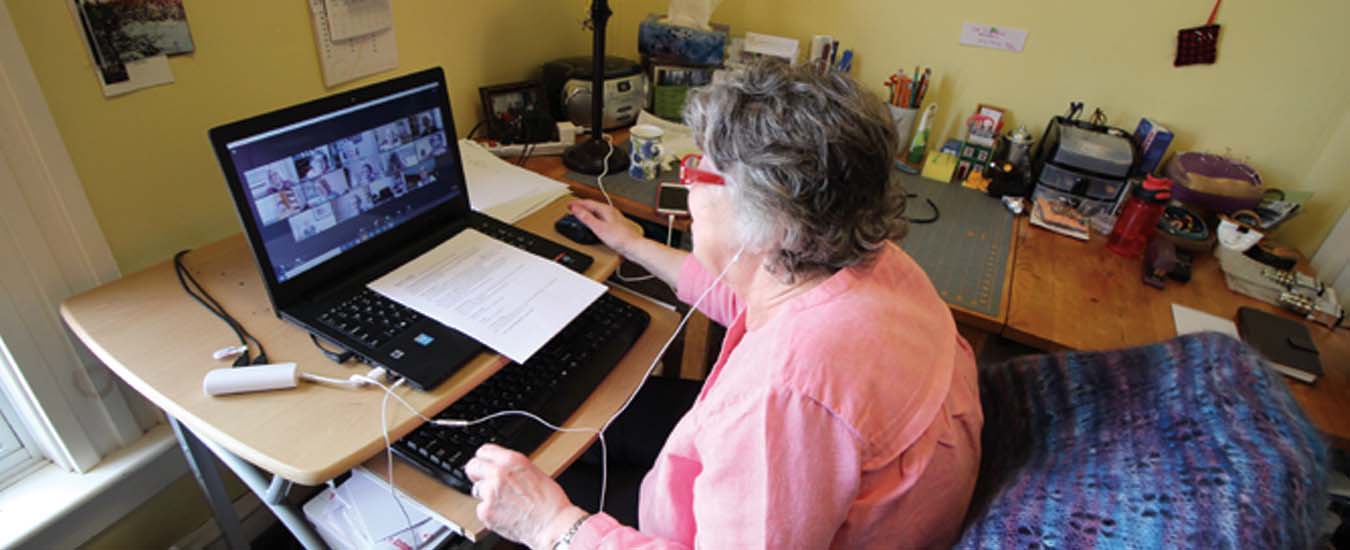A love for rug hooking and singing brought together those two passions in a unique exhibit
“It looks like you’re talking Eileen but I can’t hear anything. You must have your mute setting on.”
“Where’s that? Hold on, I see it. Can you hear me now?”
“Yes, loud and clear.”
“Louise, I’m just getting the top of your head. Can you tip your screen a bit forward?”
“How’s that?”
“You’re looking good. Now where’s Sheila Feaver? Oh, there you are.”
“Sorry, there was someone at the door.”
“Now can you all see each other on your screen? Bonnie? Anne? Gerri? Lois? Mary Anne? Nicole? Marilyn? Are we good to go?”
Thus started the first Zoom meeting of the Five Island Rug Hooking group. Not surprisingly, it took a bit of getting used to, especially for this get-together of people who are accustomed to larger, in-person gatherings. Actually, this on-screen group is a sampling of hundreds of singers who make up the six choirs and two singing groups involved in this project, and who use St. John’s as their base.
Obviously, the COVID-19 pandemic has been quite a challenge for all of us, with obstacles varying throughout the weeks and months. Depending on the circumstances, some essential activities such as grocery shopping and the like carried on; some businesses, like restaurants, got around the regulations by offering takeout. Schools turned to online education. But singing in choirs never had a chance. Social distancing with a membership of 50 to 100 people or more made singing practice and performance pretty much impossible.
This is where choir member and rug hooker Frances Ennis enters the picture. She came across a proposal call from the Craft Council of Newfoundland and Labrador Gallery looking for works “for an interactive, sensory, tactile and haptic exhibition designed to celebrate NL Craft, which stimulates the senses beyond sight… to provide a unique experience for the disability-identified community.”
Aha.
Where some would see the
pandemic as an obstacle, Frances saw this call as an opportunity to get around that obstacle. It turns out there are many singers who have more than a nodding acquaintance with rug hooking.
The Five Island Rug Hooking group, with 15-25 women at any given time, has been together since 2009. What started out as a bit of fun turned into a stellar group of rug hookers who have gone on to gallery exhibitions in Newfoundland and Ireland, produced two books about their rugs, and were featured in a one-hour television documentary titled From the Floor Up.
So, how do you combine rug hookers with “out of work” choir members and come up with a plausible idea that satisfies the terms of the Craft Council’s planned exhibition, Sensorius: Where the Skin Meets the Eye?
To begin with, the necessary forms had to be completed and sent in.

Bark O’Keefe pretends to direct a large choir of 3D hooked figures.
When CCNL curator Bruno Vinhas replied to their submission he said, “I am beyond excited to have you on board…. Your work has been selected not only on the merit of quality and innovation but also on how it will suit the disability-identified community to have a full sensory experience…”
The group was beyond excited—not only with Bruno’s response, but also with the response of the six choirs and two singing groups who eagerly bought into the project. Their presence gave the whole enterprise a depth that was to bear innovative and creative fruit. The stunning collection of hooked figures representing the Basilica, Holy Heart of Mary Alumnae, Philharmonic, St. John’s, St. Teresa’s, and the Stella Burry Inclusion choirs, along with Red Island Resettlement Girl and the Swinging Belles trios, speaks for itself.
When most people think of rug hooking they tend to picture the obvious. A square or rectangular mat with a familiar or abstract image using a variety of tactile and colourful materials. Being conscious of the need for a different and catchy approach to their project, Frances was reminded of the time when she and sister-in-law Maxine Ennis attended an international rug hooking conference in New Orleans, where they learned how to create three-dimensional hooked figures. Just the ticket for this project, she mused: Create figures that visitors can pick up to feel the texture and the shape.
But their project idea did present a unique problem for Frances and Maxine. Teaching rug hooking is one thing, but three-dimensional figures is quite another. It requires a different mindset and a different approach. That is challenging enough to teach in person but now, because of COVID-19 restrictions, much of it would have to be done via Zoom.
In theory it seemed easy enough. Luckily for them, there was already a video showing the process. More short videos were created to give members a good idea of what they were getting into and how to move forward with their project. Like many others, while Barbara O’Keefe found the project very interesting and exciting, it was also challenging. Hooking the front and back of the figures was doable. Stitching, stuffing and needle felting the finishing touches presented some problems which often required undoing and starting over again. “Because this was new to us, mistakes were made… and frustration was sometimes evident,” she commented.
This is where Sheila Feaver, with her previous doll-making skills, introduced the group to tucking features to add texture, and offered to stitch in the singing facials.
It was a team effort by the 17 women directly involved, but getting everyone onboard and getting at creating the figures were very positive first steps.
Someone who knows a lot about first steps is Marion Counsel, originally from the resettled community of Red Island, Placentia Bay, where she learned to hook rugs alongside her mother by the woodstove in their kitchen. From second hand burlap and castaway clothes to linen and bright coloured wool materials, three-dimensional figures were just another step in the evolving experience of rug hooking. To ensure her son would grow up knowing about his heritage, Marion created stories and songs to tell him about life and living on Red Island. To her surprise, the songs and stories turned into the mini-musical, Red Island Resettlement Girl. This delightful presentation, by Marion and fellow rug hookers Helen Murphy and Barbara O’Keefe, has captivated and charmed many audiences since its first show in 2014.
Many years ago, Sheila Power said in a CBC interview that “rugs tell a story.” Now she goes on to say, “Of course, so do these hooked figures. They bring to light the incredible legacy of choirs in St. John’s and throughout the Province.” To help make that story more vivid and alive, her daughter Erin Power came on board. She is an educator, a member of the award-winning Swinging Belles trio, and very comfortable with new technologies. They came up with the idea of using quick response (QR) codes as part of the exhibit; to make a pre-recorded song by, and other information from, each of the choirs and groups accessible to visitors.
Someone in the group of hookers involved with the project asked how their exhibit could reach out to those who are hearing impaired. This led to discussions with the Newfoundland and Labrador Deaf Association on the use of closed captioning and sign language. While those concepts added more work, they did fit in with the project goal. And without batting an eyelash, Erin and Sheila dug in to learn how to incorporate close captioning into the project.
What began as rug hooking has become much larger and more inclusive by involving “people with disabilities on the level we are doing in this project,” said Helen Murphy, who directs the Stella Burry Inclusion Choir. A group with members who never imagined they could be part of a choir and sing for so many audiences. “The Sensorius exhibit will draw attention to the issues of inclusion and disabilities,” she suggests, “because projects like these can increase our awareness at a deeper level so that we’re more inclined to tune in to people’s reality of living with a disability on a daily basis.”
An inspiration for this project was the Les Ms. And Friends Sing for Care annual fundraising concert, for the Bliss Murphy Cancer Centre, Patient and Family Support Fund. The event, directed by Dr. Valerie Long, invites other choirs to participate with all joining in for the finale, “I’ll Make the Difference” (A Song of Hope for Singers Around the World) by Moses Hogan. To date, this fundraiser has donated an impressive $175,000 to this support fund and in keeping with that tradition, A Moment in Time will contribute any realized profits to the Sing for Care fundraiser—which again this year may have to be virtual.
The Five Island Rug Hooking group are pleased with the overall project, especially their hooked figures. The attention to detail, commitment to excellence, and the evolving realization that these figures may outlive the singers and leave a lasting legacy. They represent camaraderie, hard work, and creativity but mostly the hope that soon the pandemic and its restrictions will pass.
Then choirs can get out there and sing!
